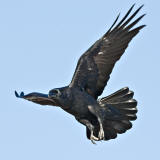
In his book, King Solomon's Ring, Nobel-prize-winner Konrad Lorenz, a renowned animal ethologist and ornithologist, wrote, among other things of his admiration for the intelligence of crows. More recent studies of the intelligence of crows have also testified to their admirable memories of events or threats which can be handed down through generations. These highly adaptable, clever birds are not admired by everyone. I do, though, like them, and always have.
In the Tantramar Marsh of New Brunswick, we saw crows and their big cousins, ravens, in abundance.
 They are impressive birds. When we lived in Tokyo, there were large crows called Jungle Crows around our compound; around all of Tokyo, actually. These birds were so large and heavy that when they walked on the metal roof of our house it sounded as though a man was up there, traipsing about. They used to prey on the feral cats that roamed the city, living off garbage, and hiding out in the sewer system.
They are impressive birds. When we lived in Tokyo, there were large crows called Jungle Crows around our compound; around all of Tokyo, actually. These birds were so large and heavy that when they walked on the metal roof of our house it sounded as though a man was up there, traipsing about. They used to prey on the feral cats that roamed the city, living off garbage, and hiding out in the sewer system.Here, where we live now, in Ottawa, we often see crows in huge, loud cawing gatherings, well-named as a "murder" of crows. And when we hear a commotion of crows, we become aware that an owl is present, with the crows harassing the owl, itself calm and studiously ignoring the hysteria of the crows. On occasion we see and hear passing ravens in our forested ravine. And we have become accustomed to regular crow clients following us to take advantage of the peanuts we leave in caches for the squirrels.
We've noticed of late that some of our neighbours' lawns have become popular with area crows. So popular that the lawns have been completely destroyed. The crows are doing what comes naturally to them; they're carnivores, and will eat just about anything, including the carcasses of dead animals they may come across. What attracts them to the lawns is the presence of hideous grubs, fat and disgusting, the larval stage of June beetles. In their search for the beetles they dig up lawns and leave devastation.
This year must have resulted in a bumper crop of June beetles laying more eggs that morph into grubs than usual. And the crows have taken note, to the immense disgust and distress of proud homeowners. Who, in turn, find nothing attractive whatever about crows.
June Bug

June Bug, common name for any of several beetles in the scarab family, also called June beetle. The adults are most common in June. In the northern United States, the name is applied to the numerous species that are known as May bugs in the southern United States, where they emerge earlier. The brown, stout-bodied adults are about 25 mm (about 1 in) long and feed on leaves. The larvae, known to horticulturists as white grubs, burrow in soil, feed on the roots of plants, and often damage grass lawns. The larval stage persists for two to three years.In the southern United States, the name green June beetle is applied to a similar green-and-brown beetle that, in the adult stages, feeds on ripe figs and other fruit. The larvae, like those of the northern June beetle, live in the ground and eat plant roots but do little damage to important plants. The name June beetle is applied in Europe to beetles closely related and similar in habits to the June beetles of the northern United States.
Scientific classification: June bugs belong to the family Scarabaeidae of the order Coleoptera. May bugs are classified in the genus Phyllophaga. The green June beetle is classified as Cotinis nitida. European June beetles are classified in the genus Rhizotrogus.
No comments:
Post a Comment